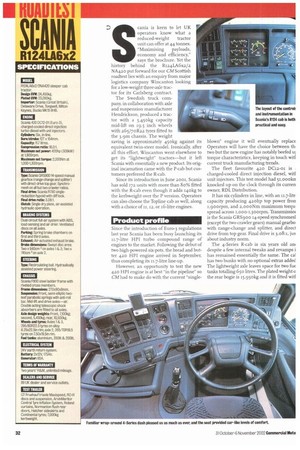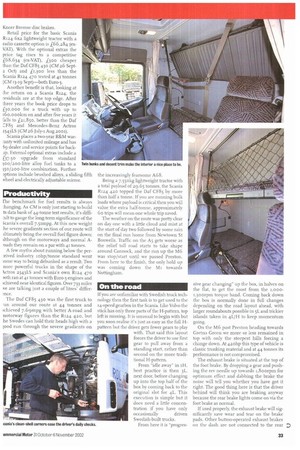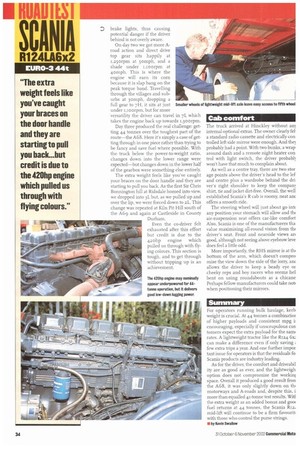cania is keen to let UK operators know what a
Page 32

Page 33

Page 34

If you've noticed an error in this article please click here to report it so we can fix it.
reduced-weight tractor unit can offer at 44 tonnes. "Maximising payloads, economy and efficiency," says the brochure. Yet the history behind the R124LA6x2/2 NA42o put forward for our CM Scottish roadtest lies with an enquiry from major logistics company Wincanton looking for a low-weight three-axle tractor for its Carlsberg contract. The Swedish truck company, in collaboration with axle and suspension manufacturer
Hendrickson, produced a tractor with a 5,450kg capacity
mid-lift on 19.5 inch wheels with 265/7oR22, tyres fitted to the 3.9m chassis. The weight saving is approximately 450kg against its equivalent twin-steer model. Ironically, after all this effort, Wincanton went elsewhere to get its "lightweight" tractors—but it left Scania with essentially a new product. Its original incarnation came with the P-cab but customers preferred the R-cab.
Since its introduction in June 2001, Scania has sold 172 units with more than 80% fitted with the R-cab even though it adds 140kg to the kerbweight over the P version. Operators can also choose the Topline cab as well, along with a choice of ci, 12., or i6-litre engines.
Product profile
Since the introduction of Euro-3 regulations last year Scania has been busy launching its 11.7-litre HPI turbo compound range of engines to the market. Following the debut of two high-powered six-pots, the bread and butter 420 HPI engine arrived in September, thus completing its 11.7-litre line-up.
However, an opportunity to test the new 420 HPI engine is at best in the pipeline" so CM had to make do with the current "single blown" engine it will eventually replace Operators will have the choice between th. two but the new engine has notably beefed ui torque characteristics, keeping in touch wit] current truck manufacturing trends The fleet favourite 420 DQ.2,-oi is , charged-cooled direct injection diesel, wit] unit injectors. This test model had 5i,000kn knocked up on the clock through its curren owner, RDL Distribution.
It has six cylinders in line, with anii.7-11tr capacity producing 42ohp top power fron 1,900rpm, and 2.000Nm maximum torqu, spread across i,000-1,3oorpm. Transmissioi is the Scania GRS900 i4-speed synchromesi (except the two crawler gears) manual gearbo with range-change and splitter, and direci drive from top gear. Final drive is 3.08:1, jus about industry norm.
The 4-Series R-cab is six years old an despite a few internal tweaks and revamps i has remained essentially the same. The cal has two bunks with no optional extras added The lightweight axle leaves space for two use tanks totalling 65o Litres. The plated weight the rear bogie is 15,95okg and it is fitted wit] Knorr Bremse disc brakes.
Retail price for the basic Scania R124 6x2, lightweight tractor with a radio cassette option is f66,284 (exVAT). With the optional extras the price tag rises to a competitive [68,634 (ex-VAT), boo cheaper than the Daf CF85 430 (CM 26 Septa Oct) and t,3oo less than the Scania R124 470 tested at 41 tonnes (CM 13-19 Sept)—both Euro-3.
Another benefit is that, looking at the return on a Scania R124, the residuals are at the top edge. After three years the book price drops to (30.000 for a truck with up to 16 o,o ookm on and after five years it Falls to 121,85o, better than the Daf CF85 and Mercedes-Benz Actros a543LS (CM 26 July-1 Aug 2001).
Scania places a two-year R&M warranty with unlimited mileage and has 39 dealer and service points for backap. External optional extras include a C37.50 upgrade from standard 100/200-litre alloy fuel tanks to a 150/200-litre combination. Further )ptions include brushed alloys, a sliding fifth wheel and electrically adjustable mirror.
Productivity
file benchmark for fuel results is always :hanging. As CM is only just starting to build ts data bank of 44-tonne test results, it's diffi:ult to gauge the long-term significance of the icania's overall 7.5impg. At this new weight he severe gradients section of our route will iltimately bring the overall fuel figure down; &hough on the motorways and normal Alaads they remain on a par with 41 tonnes.
A few myths about running below the per:eived industry rohp/tonne standard went ;ome way to being debunked as a result. Two nore powerful trucks in the shape of the kctros 2543LS and Scania's own R124 470 )oth ran at 41 tonnes with Euro-3 engines and ichieved near identical figures. Over 733 miles ye are talking just a couple of litres' differTice.
The Da f CF85 430 was the first truck to .un around our route at 44 tonnes and ichieved 7.69mpg with better A-road and notorway figures than the RI24 420, but he Swedes can hold their heads high with a ;ood run through the severe gradients on the increasingly fearsome A68.
Being a 7,550kg lightweight tractor with a total payload of 29.65 tonnes, the Scania R124 420 topped the Da f CF85 by more than half a tonne. If you are running bulk loads where payload is critical then you will value the extra half-tonne, approximately 6o trips will mean one whole trip saved.
The weather on the route was pretty clear on day one with a little cloud and mist at the start of day two followed by some rain on the final run home from Newtown St Boswells. Traffic on the A5 gets worse as the relief toll road starts to take shape around Cannock, and the run up the M6 was stop/start until we passed Preston. From here to the finish, the only hold up was coming down the MI towards Nottingham.
On the road
If you are unfamiliar with Swedish truck technology then the first task is to get used to the 14-speed gearbox in the Scania. Like Volvo the stick has only three parts of the H-pattern, top left is missing. It is unusual to begin with but you soon realise it's just as easy as the full Hpattern but the driver gets fewer gears to play with. That said this layout forces the driver to use first gear to pull away from a standing start, rather than second on the more traditional H-pattern.
From Idle away" in best practice is then 31, next door, before changing up into the top half of the box by coming back to the original slot for 4L. This execution is simple but it does need a little concentration if you have only occasionally driven Swedish-built trucks.
From here it is "progres sive gear changing" up the box, in halves on the flat, to get the most from the 1, 000L3oorpm torque band. Coming back down the box is normally done in full changes depending on the road layout ahead, with larger roundabouts possible in 5L and trickier islands taken in 4L/H to keep momentum going.
On the M6 past Preston heading towards Gretna Green we more or less remained in top with only the steepest hills forcing a change down. At 42ohp this type of vehicle is classic trunking material and at 44 tonnes its performance is not compromised.
The exhaust brake is situated at the top of the foot brake. By dropping a gear and pushing the rev needle up towards 1,800rpm for optimum effect and dabbing the brake the noise will tell you whether you have got it right. The good thing here is that the driver behind will think you are braking anyway because the rear brake lights come on via the foot brake as normal.
If used properly, the exhaust brake will significantly save wear and tear on the brake pads. Other button-operated exhaust brakes on the dash are not connected to the rear
D brake lights, thus causing potential danger if the driver behind is not overly aware.
On day two we got more Aroad action and direct drive top gear sits happily at 1,25orpm at 50mph, and a shade under Lroorpm at 40mph. This is where the engine will earn its corn because it is slap bang on the peak torque band. Travelling through the villages and suburbs at 3omph. dropping a full gear to 7H, it sits at just Smaller wheels of lightweight mid-lift axle leave easy access to fifth wheel under 1,100 rpm, but for more
versatility the driver can travel in 7L which takes the engine back up towards 1,300rpm.
Day three produced the real challenge; getting 44 tonnes over the toughest part of the route—the A68. Here it's simply a case of getting through in one piece rather than trying to be fancy and save fuel where possible. With the truck below the power-to-weight ratio, changes down into the lower range were expected—but changes down in the lower half of the gearbox were something else entirely.
The extra weight feels like you've caught your braces on the door handle and they are starting to pull you back. As the first Sir Chris Bennington hill at Ridsdale homed into view, we dropped into 3L but, as we pulled up and over the lip, we were forced down to 2L. This change was repeated at Kiln Pit Hill south of the A69 and again at Castlesicle in County Durham.
Even the co-driver felt exhausted after this effort but credit is due to the 42ohp engine which pulled us through with flying colours. This section is tough, and to get through without tripping up is an achievement.
Cab comfort
The truck arrived at Hinckley without an internal optional extras. The owner clearly fel. a standard radio cassette and electrically con trolled left side mirror were enough. And thq probably had a point. With two bunks, a wrap around dash and a remote night heater con trol with light switch, the driver probabll won't have that much to complain about.
As well as a centre tray, there are two stor age points above the driver's head to the lef and centre plus a wardrobe behind the dri ver's right shoulder to keep the compan shirt, tie and jacket dirt-free. Overall, the well established Scania's R cab is roomy, neat anc offers a smooth ride.
The steering wheel will just about go int( any position your stomach will allow and du air-suspension seat offers car-like comfort Also, Scania is one of the manufacturers tha value maximising all-round vision from th( driver's seat. Front and nearside views an good, although not seeing above eyebrow leve does fed a little odd.
More importantly, the RH S mirror is at th( bottom of the arm, which doesn't compro mise the view down the side of the lorry, an( allows the driver to keep a beady eye or cheeky reps and boy racers who seems hel bent on using roundabouts as a chicane Perhaps fellow manufacturers could take not when positioning their mirrors.
Summary
For operators running bulk haulage, kerb weight is crucial. At 44 tonnes a combinatioi of higher payloads and consistent mpg encouraging, especially if unscrupulous cus tamers expect the extra payload for the sam■ rates. A lightweight tractor like the R12.4 6L can make a difference even if only saving ; few extra trips a year. And one further impor tant issue for operators is that the residuals fo Scania products are industry leading.
As for the driver, the comfort and driveabil Fly are as good as ever, and the lightweigh option does not compromise the workiq space. Overall it produced a good result fron the A68, it was only slightly down on fit, motorways and A-roads and, despite this, i more than equalled 41-tonne test results. Witl the extra weight as an added bonus and goo fuel returns at 44 tonnes, the Scania RI2, mid-lift will continue to be a firm favourit with those who control the purse strings.
• by Kevin Swallow




























































































































































